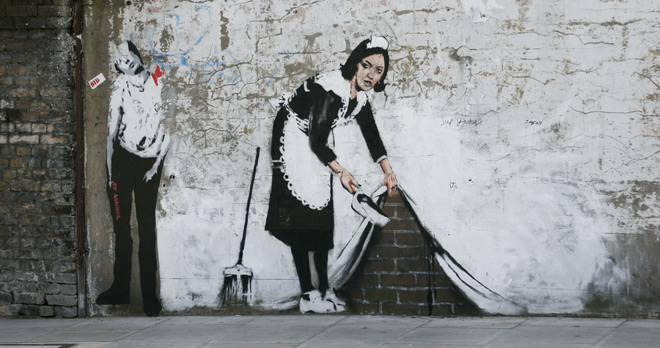Banksy murals – who’s the copyright owner?

The law
Under current UK copyright legislation (The Copyright, Designs and Patents Act 1988), the first owner of an ‘artistic work’, which the Banksy mural is, will always be the creator or artist. Ownership of copyright gives the owner the exclusive right to copy, issue copies and lend the work to the public. Therefore while the wall may belong to the landlord in question, copyright in the mural will automatically belong to Banksy by virtue of him being the creator. No matter whether the wall is sold or not, the copyright in the mural will remain with Banksy unless he transfers his rights with a signed legal document.
Consequently, as Banksy owns the copyright, it is Banksy who has the right to copy and issue copies of the mural to the public. With the rise of smart phones and sites like Instagram, taking pictures and posting these on social media is commonplace. However, it should be remembered that copyright exists in two-dimensional works of art, such as murals, even if they are displayed in public places.
What about photos of Banksy murals?
Taking photos of artistic works is in reality unlikely to cause many problems, as the artist is unlikely to object. This is largely because under the Copyright, Designs and Patents Act 1988, there is an exception which allows copying for the purpose of “criticism or review”. This ‘fair dealing’ exception arguably covers posting photos of artistic works on sites such as Instagram as it could be said that the purpose of such as post is for others to comment on and thus ‘review’ the work. There is also the ‘incidental inclusion’ exception, which permits photographs of a mural or artwork as long as it is in the background of your photograph. If the artistic work is the main focus, this is technically an infringement of copyright unless you are able to rely on the criticism/review exception. But be warned - taking photos of an artwork and making further copies, would not only be an infringement of copyright, but also commercially objectionable to the copyright owner (the artist), as such copies would impact on the artist’s ability to sell copies himself.
Expert opinion
It is also worth mentioning S.62 of the Copyright, Designs and Patents Act 1988 – this permits people to take photos of buildings and sculptures if in a public place. However this section does not appear to allow copying of street art or murals, like Banksy’s. Could there be a reason for this?
Victoria Jones, expert Intellectual Property Barrister at 3PB Chambers , argues that “the law in this area needs some updating to take account of our modern world, new forms of art and the technology that makes sharing images so easy. While s.62 allows for the taking of photographs of buildings, sculptures and certain other artistic works which are permanently situated in a public place or in premises open to the public, the exception does not include graphic works and therefore graffiti. Why should someone photographing a sculpture be allowed such an exception but not someone photographing Banksy’s work?”
So it is possible that if a Court were ever faced with this issue, it might indeed take a pragmatic approach to the matter and conclude that street art should be treated in the same manner as sculptures.